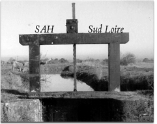Biology / Ecology
The White Stilt (Himantopus himantopus) is a wading bird (long-legged bird frequenting wetlands) perched on two long pink and thin legs. It belongs to the family of Recurvirostridae.
It nests preferentially in brackish or salt marshes. It can be found on weakly herbaceous islets (often with a vegetation not exceeding 20 cm), on bunds separating the basins or on artificial islets but especially in uncultivated salt pans.
It gathers in small colonies, sometimes mixed with elegant Avocets (Recurvirostra recurvirostra). The laying occurs from the beginning of April to the end of June. The chicks are nidifuge, they leave the nest shortly after hatching and search for their own food. It feeds in shallow waters by pecking its prey (insects, crustaceans, aquatic larvae) in sand or water.
Protection and conservation status
Protected species in France, listed in Annex I of the Birds Directive.
It is classified as “Low consideration” on the red list of nesting birds in France and Pays-de-la-Loire.
Distribution and status of populations on Natura 2000 sites
The White Stilt is found during nesting periods in western and southern Europe, especially in countries bordering the Mediterranean, as well as along the French Atlantic coast from the Brittany coast to the Gironde estuary. This migratory species spends winter in North and West Africa as well as in the Iberian Peninsula.
It deserves special attention because its breeding populations are concentrated on a reduced number of sites.
In France, in 2007, the population was estimated at 1,700 to 3,600 breeding pairs
In the area covered by the LIFE Sallina project, the workforce is as follows:
– Between 300 to 600 couples on the Marais Breton and the island of Noirmoutier (2017). – Between 90 and 93 breeding pairs were identified in the Guérande and Mès salt basins in 2019. The monitoring carried out did not allow a precise evaluation of the number of breeding pairs, these data will be specified during the 2020 monitoring
Conservation objectives / threats / actions planned in LIFE
This species is mainly threatened at the time of its reproduction by disturbances and predation.
The actions planned in LIFE targeting more specifically the Avocet elegant will be able to benefit this species and in particular:
– Promote hydraulic management adapted to its requirements in salt marsh basins.
– Create nesting islands or restore existing islets.
– Reduce the intensity of predation by dispersing populations within LIFE sites and increasing potential nesting sites.
– Reduce the disturbances linked to leisure activities in the most sensitive sectors.













